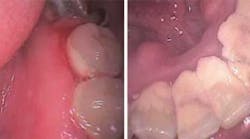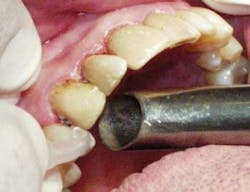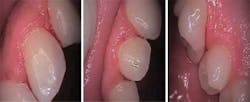Dental team remains focused on delivering optimal care
By David P. Reichwage, DDS; Cassie M. Jackson, RDH; Denise L. Marr, CDA, EFDA; Kristen M. Nuthals, CDA, EFDA; Amber M. Jaress, CDA, EFDA
Question: Who and what determines a standard of care for professions?
Is it dental and medical schools, state boards, continuing education seminars, the legal profession and bar association, or individual practitioners and their own level of knowledge, skill, and judgment?
At a recent dinner meeting of professional colleagues and hygienists, I overheard a conversation across the table about periodontal charting and office protocol for recare patients. These were people from a prominent established practice in the area. "Well, I don't think I have done a periodontal chart since school."
Question: How can the standard of care in dentistry be so arbitrary and unregulated and subject to the whims and prejudices of individual offices?
How can such a wide range of clinical data be used so differently between offices on similar clinical procedures? The medical profession has a standard of care for CBC, urinalysis, and blood pressure measurement. Dentistry has definitions of care for bleeding upon probing, bleeding upon scaling, pocket depth, tissue appearance, loss of lamina dura, etc. In addition, the relationship from oral health to systemic health has also been established. Blood pressure is not measured without a gauge. How can periodontal health be measured without a probe? EKG cannot be done without leads and a treadmill; how can soft tissue health be determined without a yearly comprehensive periodontal charting?
We see a dilemma. What is taught, talked about, and actually done are often very different from each other. Statements, which pretend to be value laden, are both slanted and bigoted.
The American Dental Association has estimated that 80% of American adults have periodontal disease, including gingivitis. According to the American Academy of Periodontology, more than a third of Americans over age 30 have periodontitis. In addition, recent research has offered a growing amount of compelling evidence and data showing direct links between periodontal health and systemic health. These links include the inflammatory effects of periodontal disease correlating with great risks of heart attack, stroke, diabetes, lower birth weight babies, and premature births.
Our office finds it disturbing that there is such a high prevalence of periodontal disease – almost to epidemic proportions – in a field that has experienced vast technological advances.
It is the philosophy of our office to be patient centered, and it is our mission to diagnose and treat periodontal disease, including gingivitis. The methodology to accomplish this is conservative nonsurgical treatment with active patient involvement. We use a systematic approach to patient care, and the model we have created is based on our standard of care. Since we use it daily on every patient, our model is continually tested and evaluated based on predictions of treatment outcome, as well as direct observations of its effectiveness. Our evaluation includes the following:
- Occlusal evaluation and anterior guidance
- TMJ examination and muscle palpitation
- Head and neck exam and oral cancer screening
- Charting existing restorations and missing teeth
- Diagnosing areas of caries, taking a full-mouth series of periapical films, bitewings, and panoramic X-ray
- Ascertaining the patient's concerns
- Establishing goals for treatment
- Considering motivational factors for the patient, as well as personality profiles
Our periodontal evaluation form also becomes an educational tool for each patient. We record six-point pocket depths for each tooth, bleeding points, recession, furcations, mobility, tissue contour, plaque scores, and calculus present. We explain to our patients that this is the most efficient way to determine their progress and periodontal health at a glance. We also point out to the patient all of the etiological factors that affect periodontal health and may compromise treatment. These include genetics, general systemic health, hormonal changes, diet, oral hygiene, occlusion, tobacco use, and stress.
It becomes evident to patients that they can develop a "barometer" to measure their periodontal health in susceptibility to disease. All of the data and variables are used to map the course of treatment. This "map" is developed with patient input based on their own treatment goals. They become actively involved in their own treatment recommendations.
Conservative treatment
Co-diagnosis and treatment planning with the patient set the stage for the next step – providing conservative treatment. This includes the number of therapy appointments to be scheduled, the sequence in scheduling, and the actual clinical modalities to be used. The ultimate goal of periodontal therapy is to stop disease progression and to stabilize and improve tooth attachment.
Treatment includes the use of traditional hand instruments as well as microultrasonics for debridement and irrigation. Microultrasonic tips give better access to deep, narrow pockets as well as furcations. In addition, the fluid lavage of microultrasonics flushes bacteria and bacterial toxins, and the cavitational effect of the water from the ultrasonic tip breaks the cell walls of bacteria. Water and chlorhexidine are used in the lavage (Dual Select by Dentsply).
Dr. Reichwage uses a diode laser to remove diseased epithelium, and for bacterial decontamination. Local antimicrobials such as Atridox (Collagenex Pharmaceuticals) are used when pocket depths are 5mm or greater. Lastly, Periostat (Collagenex Pharmaceuticals) is used in three, six, nine, or 12-month intervals depending on the patient's progress. This subantimicrobial dose of doxycycline (20mg) used twice daily is FDA approved for enzyme suppression to manage periodontitis.
Regardless of the treatment modalities used, the purpose is to achieve a gradual healing process and continue treatment until the disease process is controlled. Co-therapy by the patient is critical. Our recommendation of this includes daily use of a power toothbrush such as Sonicare, floss, Hydrofloss hydromagnetic oral irrigator, and chlorine dioxide toothpaste and rinse such as CloSYS.
Follow-up after periodontal therapy is crucial. Our system involves re-evaluation after six weeks and again after three months. Maintenance intervals of supportive periodontal therapy are determined by the progress patients have achieved. Our typical recommendation is a three-month cycle but it can be as short as eight weeks.
Case report 1
The patient was a 45-year-old male who reported it had been at least 20 years since his last dental visit. His primary concern was that he had noted changes in his gum tissue, especially bleeding when he brushed his teeth. He suspected this could be detrimental to his oral health and possibly related to chronic digestive problems as well as weight loss.
We conducted a diagnostic and comprehensive oral evaluation. In addition we performed co-diagnosis techniques with the patient by using a hand mirror, radiographs, and intraoral camera in order to have the patient involved in the clinical data process and understand the findings as we presented them. It was noted that his medical history was negative and presented no contributory data. The following findings were noted during his evaluation (see Figure 1).
- Plaque: moderate
- Bleeding on scaling: moderate to heavy
- Tissue response: moderate to heavy
- Sensitivity: maxillary left tissue
- Supra calculus: heavy and generalized
- Sub calculus: heavy and generalized
- Tissue texture: inflamed, red, bulbous
- Periodontal classification: II-III (early - moderate periodontitis)
- Periodontal Health Index (PHI): 55 (4mm+ pockets)/102 (bleeding points)
- Diagnosis: periodontitis with areas of advanced periodontitis
Treatment plan – At the treatment plan consultation appointment we reviewed our findings, the etiology behind our concerns, and the treatment plan necessary to achieve perfect tissue health. Treatment would consist of 4-6 hours of nonsurgical, conservative, periodontal therapies, with a 6-week supportive periodontal maintenance.
Procedure – At the initial diagnostic appointment, a full-mouth superficial debridement was performed using microultrasonic instrumentation. The patient was disclosed and given instructions for his co-therapy at home with a Sonicare powered toothbrush as well as proper flossing techniques with Eez-Thru flossers (Sunstar). He was also started on CloSYS (Rowpar Pharmaceuticals) mouth rinse and CloSYS toothpaste with the active ingredient of chlorine dioxide, which is known for its antimicrobial properties. The patient made three reservations for periodontal therapies.
Two weeks later, treatment began on the upper and lower right side and started with application of topical anesthetic and local anesthetic on the upper and lower right side.
Once profound anesthesia was obtained, treatment was initiated by using the microultrasonics to remove supragingival and subgingival calculus. Next, scaling and root planing were performed to fine scale and remove any residual calculus. Scaling and root planing were followed by microultrasonics with Acclean chlorhexidine gluconate 0.12% (Henry Schein) to flush out and irrigate pockets (see Figure 2).
The last part of the procedure consisted of using the initiated diode soft tissue laser (Premier Aurora). The laser was set at 1.4 continuous wave and was used to remove diseased epithelium in the periodontal pockets with a brush stroke motion. The laser was then set to 1.2 continuous wave to decontaminate the pockets. Vitamin E gel was then placed on the tissue to augment healing. Follow-up care instructions were reviewed with the patient (see Figure 3).
Two weeks later, the same procedure was done on the upper and lower left side. In addition, the lower and upper right were re-treated with the ultrasonic and irrigated with chlorhexidine. Each appointment included ongoing monitoring of the oral hygiene process and healing.
Results – At this time, a marked decrease in inflammation was noted, and gingival tissue was responding well to therapy. The tissue was generally pink and no longer bulbous. Some marginal redness was noted around the third molars.
The following clinical findings were noted at the sixth week appointment (see Figure 4):
- Plaque: slight
- Bleeding upon scaling: moderate around second and third molars
- Bleeding upon probing: moderate around molars at 39 points
- Supra calculus: very light on the lingual of the lower anterior teeth
- Sub calculus: none
- Tissue texture: generalized pink with localized areas of red with some inflammation around third molars
- Periodontal classification: II (early periodontitis)
- eriodontal Health Index (PHI): 27/39 decreased from 55/102!
- Recall: three months
The patient noted he was happy with the results and no longer had bleeding at home when he brushed.
Case report 2
A 15-year-old female patient presented with a desire to update her dental care. It had been about one year since her last routine cleaning and radiographs. She stated she had noticed bleeding from her mouth when she brushed her teeth. Her mother was included in the original interview and history.
We conducted a comprehensive clinical and diagnostic evaluation. The patient's gingiva was irregular with red, rolled margins in multiple areas as well as the presence of plaque. We performed co-diagnosis with this patient using a hand mirror and intraoral camera in order to have the patient involved in the clinical data process and also understand the findings as we presented them. It was noted that her medical history was negative and presented no contributory data. The following findings were noted from the complete clinical evaluation (see Figure 5).
- Plaque: light
- Bleeding on scaling: moderate generalized
- Tissue response: moderate generalized
- Sensitivity: in local areas when flossing
- Supra calculus: none
- Sub calculus: none
- Stain: none
- Tissue texture: red, rolled margins, inflamed
- Periodontal classification: IB (gingivitis)
- Periodontal Health Index: 3/38
- Diagnosis: generalized gingivitis
Treatment plan – We reviewed the radiographs, and there was no evidence of bone loss. Treatment recommendations included two to three hours of gingivitis therapies, CloSYS mouth rinse and toothpaste, and a Sonicare toothbrush. Both the patient and her mother stated that no one had shared this information during previous treatment.
Procedure – Two weeks later, treatment began on the entire mouth and started with application of topical anesthetic along the gingival margins. Treatment was initiated by using the microultrasonics to remove plaque and biofilm. Scaling was next performed to fine scale and remove any residual biofilm. This was followed by microultrasonics with Acclean chlorhexidine gluconate 0.12% (Henry Schein) to flush out and irrigate diseased tissue.
Two weeks later, the entire gingivitis therapy procedure was repeated. Overall, tissue was reported to appear healthier and showed response from the first therapy. The patient was congratulated for her work and progress with her home care. A six-week supportive therapy was scheduled.
Results – At this time, a marked decrease in inflammation was noted, and gingival tissue was responding well to therapy. The tissue was generally pink and no longer had rolled margins.
The following clinical findings were noted at the six-week appointment (see Figure 6):
- Plaque: light
- Bleeding on scaling: light, localized
- Tissue response: light
- Sensitivity: lower posterior molars
- Supra calculus: none
- Sub calculus: none
- Stain: none
- Tissue texture: more pink, local areas of red
- Periodontal classification: Localized gingivitis
- Periodontal Health Index: 1 pocket/18 bleeding points
In our opinion, the standard of care that determines protocol for any and all procedures in dentistry should apply equally from peer review committee to megapractices to dentistry in the small offices. We have found that when the standard of care is practiced, applied by the book, and follows accepted protocol, it produces a win/win/win scenario for patient/team/practice!
David Reichwage, DDS, has practiced family dentistry in Fort Wayne, Ind., for over 30 years. He has completed courses in laser dentistry, and advanced cosmetic, periodontal, and restorative dentistry. He can be reached at (260) 426-1086, www.fortwaynesmiles.com, or e-mail at [email protected].
Cassie Jackson, RDH, is a 2004 graduate from Indiana University-Purdue University, JP Institute, LVI, and Comprehensive Care Institute, and holds a certificate from the Periodontal Laser Academy.
Denise Marr, CDA, EFDA, a treatment coordinator, is a 1999 graduate from Indiana-Purdue University and Indiana University's Expanded Function Dental Course, JP Institute, LVI, PAC, and Comprehensive Care Institute.
Kristen Nuthals, CDA, EFDA, a treatment coordinator, is a 2005 graduate from Indiana-Purdue University and Indiana University's Expanded Function Dental Course, JP Institute, LVI, and Comprehensive Care Institute.
Amber Jaress, CDA, EFDA, a treatment coordinator and expanded function dental assistant, has been schooled at LVI, PAC, JP Institute, and Comprehensive Care Institute.












